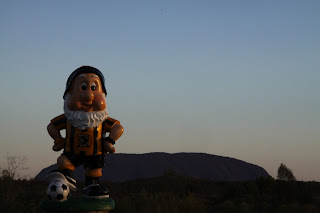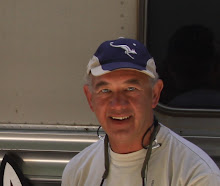There were more entrants than I had imagined for yesterday's Humber Bridge Half Marathon - just over 2,000. It was hot even before we began the 13 mile gruelling run and contestants sheltered in the shade around the start point.
I got off to a good start, maybe a little too fast, but I had trained for 3 months for this and was feeling confident. That confidence waned as I hauled myself up the first of the hills at about 4 miles. My legs began to feel tired and the temperature was rising.
I reached half-way at just under an hour and was on target for the 2 hour finish I had set myself.
As predicted, the ninth mile was torture. An undulating mile long climb, it tested my stamina to the limit. Many people began to walk. I just pushed on, knowing that if I stopped I would never get going again. Finally, the haul was over and I reached the 10 mile marker. Just three miles to go. What could go wrong?
The heat and the climbs had sapped me and as I reached the final mile I was running on sheer will power. There were just 7 minutes until the 2 hour mark, so it was obvious I was not going to reach my target. Finishing became my objective even though my body screamed at me to stop this madness. I pushed on.
Less than half a mile from the finish was when it happened. I became light headed and then bang! Down I went. Heat exhaustion had taken me.
I don't remember falling. It was as if I had been shot. I couldn't move a muscle. There were people all around me. For some reason I thought I was surrounded by police officers and had been arrested. I began to panic and struggled to breathe.
An ambulance crew arrived and I heard calming, reassuring voices. They strapped me to a board and put me in the ambulance. Hands were all over me - attaching electrodes, inserting oxygen tubes, taking blood, fixing me to a drip. I am fortunate to have been healthy all my life. This was a new and very frightening experience. I know it is a cliché, but I didn't know what day it was. I struggled to remember but it was no good.
My condition stabilised, we made the journey to Hull Royal where I spent the afternoon on a drip and gradually got better.
The local newspaper reports that the race took place on the hottest day of the year, with temperatures peaking at 28 degrees.
So, a task failed. There are other half marathons but I have no intention of entering them. 10k's on cool days for me in the future.
Yet it wasn't all failure. The race epitomised what my gap year has been about. I have been to wonderful places and done exciting things. Wherever I have gone though it has always been the kindness and generosity of people that has shone through. The fact that I am well enough to be typing this is testimony to the legion of people who helped me yesterday. Some of those who came to my aid must have been runners who rather than push on to the finish gave up their race to help me. When I was released from hospital, perhaps a little foolishly, I decided to take a taxi to recover my car.
On arrival back at the bridge I found the field where cars had been parked was secure. There was a note on my windscreen with a number to ring to have the gate opened. As I waited for the gate to be unlocked I was approached by a man and his wife. He turned out to be a retired police officer from a southern force. He was concerned for my safety and insisted that he drove me home whilst his wife followed in their car. I protested but gave in as I knew he was right and I wasn't really fit to drive.
For me, that is what travel and maybe life is about - the total and unexpected kindness of strangers.
I got off to a good start, maybe a little too fast, but I had trained for 3 months for this and was feeling confident. That confidence waned as I hauled myself up the first of the hills at about 4 miles. My legs began to feel tired and the temperature was rising.
I reached half-way at just under an hour and was on target for the 2 hour finish I had set myself.
As predicted, the ninth mile was torture. An undulating mile long climb, it tested my stamina to the limit. Many people began to walk. I just pushed on, knowing that if I stopped I would never get going again. Finally, the haul was over and I reached the 10 mile marker. Just three miles to go. What could go wrong?
The heat and the climbs had sapped me and as I reached the final mile I was running on sheer will power. There were just 7 minutes until the 2 hour mark, so it was obvious I was not going to reach my target. Finishing became my objective even though my body screamed at me to stop this madness. I pushed on.
Less than half a mile from the finish was when it happened. I became light headed and then bang! Down I went. Heat exhaustion had taken me.
I don't remember falling. It was as if I had been shot. I couldn't move a muscle. There were people all around me. For some reason I thought I was surrounded by police officers and had been arrested. I began to panic and struggled to breathe.
An ambulance crew arrived and I heard calming, reassuring voices. They strapped me to a board and put me in the ambulance. Hands were all over me - attaching electrodes, inserting oxygen tubes, taking blood, fixing me to a drip. I am fortunate to have been healthy all my life. This was a new and very frightening experience. I know it is a cliché, but I didn't know what day it was. I struggled to remember but it was no good.
My condition stabilised, we made the journey to Hull Royal where I spent the afternoon on a drip and gradually got better.
The local newspaper reports that the race took place on the hottest day of the year, with temperatures peaking at 28 degrees.
So, a task failed. There are other half marathons but I have no intention of entering them. 10k's on cool days for me in the future.
Yet it wasn't all failure. The race epitomised what my gap year has been about. I have been to wonderful places and done exciting things. Wherever I have gone though it has always been the kindness and generosity of people that has shone through. The fact that I am well enough to be typing this is testimony to the legion of people who helped me yesterday. Some of those who came to my aid must have been runners who rather than push on to the finish gave up their race to help me. When I was released from hospital, perhaps a little foolishly, I decided to take a taxi to recover my car.
On arrival back at the bridge I found the field where cars had been parked was secure. There was a note on my windscreen with a number to ring to have the gate opened. As I waited for the gate to be unlocked I was approached by a man and his wife. He turned out to be a retired police officer from a southern force. He was concerned for my safety and insisted that he drove me home whilst his wife followed in their car. I protested but gave in as I knew he was right and I wasn't really fit to drive.
For me, that is what travel and maybe life is about - the total and unexpected kindness of strangers.

















